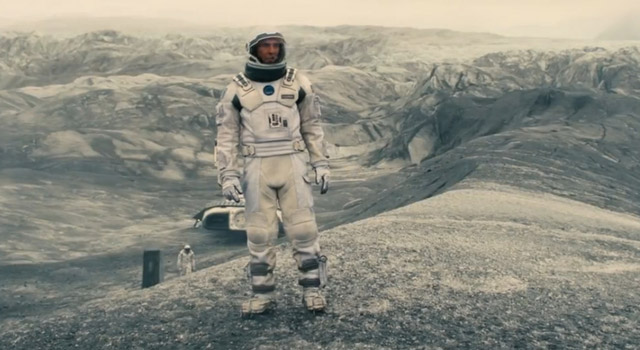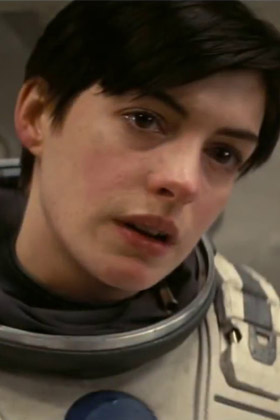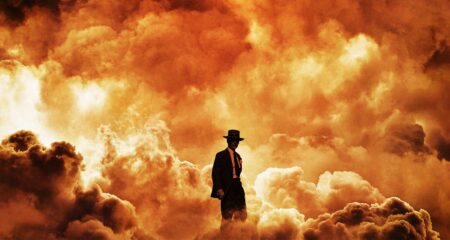
“We used to look up in the sky and wonder about our place in the stars,” grumbles actor Matthew McConaughey as Interstellar’s former astronaut and reluctant farmer, Cooper. “Now we just look down and wonder about our place in the dirt.” He could as well be talking about the film itself, which soars when it takes to space and drags when it comes back to earthly matters of love and family.
Directed by Christopher Nolan and scripted by him and his brother Jonathan, Interstellar is about as daring and indulgent a multiplex movie as we’ve seen this year. It’s a film that strives to be at once cosmic in reach and intimate in feel, a self-conscious attempt to reconcile the cerebral stoniness of Stanley Kubrick with Steven Spielberg’s sentimentality.
Interstellar is a rarity in the movies today — a hard science-fiction film with blockbuster production values. Spoiler alert: there are no talking raccoons or Norse gods here. Instead, Interstellar toys with scientific concepts such as wormholes and black holes to speculate about how humanity might work to save itself if it became necessary to abandon the planet.

In Interstellar, a blight is ravaging the world’s crops. The surviving humans face extinction by starvation and suffocation as the plant disease depletes crop varieties and breathable air. Cooper and his daughter Murph (Mackenzie Foy) stumble across the remnants of Nasa, now working in secret to find a way to get humanity off Earth.
Here, Cooper encounters Dr Brand (the reliable Michael Caine), who convinces him to lead an expedition to find a habitable planet through a wormhole that has conveniently opened near Saturn. That’s about as much as I’ll reveal of the plot, out of respect for the filmmakers who managed to keep many of its details secret until release. (That said, the way the film plays out won’t really surprise anyone who has read much science-fiction.)
In the run-up to Interstellar’s launch, much was made of the participation of respected theoretical physicist Kip Thorne as a consultant and executive producer. Though other astrophysicists have criticised many points of the film’s science, Nolan does a good job of making it accessible and (until the mawkish third act) mostly believable.
In particular, the visual representation of space travel, distant planets and black holes are compelling. Thorne worked with the visual effects team to create computer-based effects to ensure that the depiction of black holes adhered closely to today’s mathematical models — a process he claims yielded new insights into the phenomenon.
Other visual effects in the film are as impressive — from the lived-in interiors of spacecraft to the bleak landscapes of faraway planets, from tidal waves on watery worlds to dust storms on Earth. Nolan makes some of today’s best-looking pictures because he is one of the few directors to stand fast against 3D (this film has a stunning Imax presentation) and because he favours practical effects over CGI whenever possible.
Interstellar visual effects feature (mild spoilers):
It’s a pity that a director with Nolan’s eye for the image does not have more faith in his ability to tell a story through visuals rather than endless dialogue. Where Kubrick uses images and well-chosen music to relay complex, abstract ideas in 2001, Nolan bludgeons you with exposition in Interstellar. This is a weakness of many of Nolan’s films — many of the characters in The Dark Knight Rises could’ve been called Exposition Man or The Explainer — but here some of the dialogue is especially awkward.
The cast — including Anne Hathaway as Brand’s stoic daughter, Amelia; Jessica Chastain as a fiercely dedicated scientist; McConaughey applying his trademark Southern drawl — does its best with the material, but spends a lot of its time fighting the cumbersome writing.
Still, the space stuff in Interstellar is enjoyable, even when it’s nonsense. It’s the film’s emotional thread that is unsatisfying, culminating in a series of third act contrivances at which even M Night Shyamalan might balk. Science gets thrown out the window for metaphysical hooey, and we’re told love is all you need. It’s a take on astrophysics with which Oprah might agree. — © 2014 NewsCentral Media
Read more:
- The science of Interstellar (major spoilers)
- Interview with Jonathan Nolan (major spoilers)




